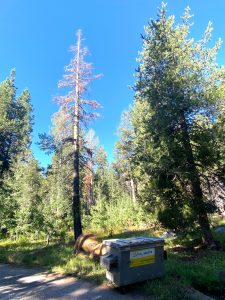Calaveras County, CA – Stanislaus National Forest (STF) officials want to remind visitors about the dangers of hazardous trees and offer some safety tips.

At the Big Meadows Campground on the Calaveras Ranger District yellow caution tape warns campers of a hazardous dead tree just across the road, as can be seen in the photos. Forest officials explain, “A ‘hazard tree’ is a tree that has a structural defect that makes it likely to fail in whole or in part. Falling trees are an ever-present hazard when traveling or camping in the forest, yet too often we are unaware of the risks associated with defective trees.”
Those defects come from age, fire and disease. Forest officials have provided these safety tips when dealing with dead or hazardous trees:
- Be aware of your surroundings as trees can fall without warning. Be particularly watchful when it’s windy or following a snowstorm when branches are covered with snow. Avoid parking or camping in areas where trees could fall.
- Avoid dense patches of dead trees. Limbs and damaged trees may fall at any time. Trees without needles, bark, or limbs may indicate structural defects. Trees with conks, broken tops, basal scars, numerous downed limbs, ants, or an abundance of woodpecker holes may have internal rot.
- Beware of hazardous trees due to ice storms or insect damage. Ice storms can inflict serious damage to trees, uprooting or breaking off large limbs. Cracks can develop in large branches which, although they are damaged, do not fall from the tree. Such branches can present a hazard to people or property long after the ice has melted.
- Look up while on trails, especially when it’s windy. Stay out of the forest when there are strong winds that could blow down trees. If you are already in the forest when winds kick up, head to a clearing out of reach of any potential falling trees.
- Park close to a main road rather than on a spur or one-way section when driving in remote areas of the forest to avoid being trapped if a tree falls across the road.

